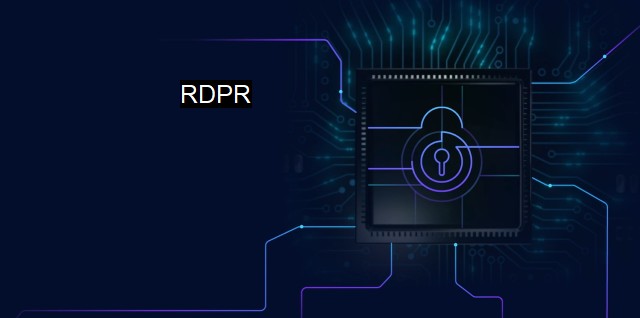What is RDPR?
RDPR Threats: How Attackers Use Remote Desktop Protocol Reflection to Control Victim’s System - and How Endpoint Detection and Response (EDR) Can Combat it
RDPR, also known as Remote Desktop Protocol, is a significant protocol developed by Microsoft. This protocol allows a user to remotely connect to another computer running Microsoft's Windows operating systems or to a connected computer. Usually utilized for management tasks such as software installation and troubleshooting as well as accessing desktop files, the RDPR has significantly impacted the field of antivirus and cybersecurity by increasing both security-related concerns and seeking solutions to these concerns.The RDPR integrates encryption into its services, which ensures that the data is well-protected while being transferred between the host and the client computers, increasingly critical in the evolving era of cyber threats and attacks. Even though this encryption prevents any unauthorized access and guarantees user security, this is not set by default and needs to be turned on manually - the main area of concern.
Another significant characteristic of RDPR is that it is firewall friendly. RDPR provides the users with multiple network channel supports, again increasing its utility standing when it comes to antivirus and cybersecurity concerns. Due to its firewall-friendly nature, RDPR's services can be often misused by attackers who sneak in the malicious software or even ransomware into the system. For instance, RDPR can be very vulnerable to brute-force attacks. In this type of attack, the password of an active RDPR can be guessed through trial and error methodology, leading to immense cybersecurity threats.
The usage and accessibility of RDPR are also quite alarming, considering innumerable remote desktop applications like Teamviewer, Chrome remote desktop, etc., providing users this service. This easy accessibility, combined with poor digital safety practices amongst users, would inevitably lead to a massive threat regarding cybersecurity within vulnerable systems. An area of immense concern is the absence of multi-factor authentication, which can cause unauthorized access to casual users into a system or network.
Considering the formidable threat caused due to such vulnerabilities, antivirus software connecting through RDPR has immense work to do. Indeed, antivirus software plays a significant role in countering the misuse of RDPR and warding off any potential threat to cybersecurity.
Antivirus utilities installed in servers connected through RDPR must feature real-time protection and heuristic detection methodologies, securing the systems from harmful malware or other threats. The antivirus software should also be capable of scanning encrypted data packers travelling through this protocol, ensuring the nullification of any cybersecurity threat. Hence, it becomes paramount to have top-of-the-range antivirus utilities guarding systems that are connected through Remote Desktop Protocol.
In the light of this scenario, organizations and institutions need to adopt improved cybersecurity practices when utilizing RDPR. Companies should focus on fostering cybersecurity hygiene and ensure that all RDPR services are well-encrypted, multi-factor authentication is always in use, and the links to which the computers are connected to are trustworthy. A prime focus should be on adopting the highest form of encryption standard, which Schwartz encryption and similar measures should significantly help.
As we step into a new age of smart homes and organizations with extensive use of inter and intranet, RDPR's usage will inevitably grow. this extensive usability may result in heightened vulnerability to cyber threats if antivirus and cybersecurity measures are not employed effectively. rigorous practices and optimum security solutions are needed to mitigate the risks associated with the Remote Desktop Protocol usage. RDPR, a critical aspect of modern-day communication, must be carefully monitored to ensure the security of connected systems from everywhere.

RDPR FAQs
What is rdpr?
Rdpr is a term used in the field of cybersecurity and antivirus. It stands for Remote Desktop Protocol (RDP) and is a proprietary protocol developed by Microsoft to allow remote access to another computer over a network.How does rdpr work?
Rdpr works by enabling a user to connect to another computer over a network and control it remotely. The user can access all applications, files, and resources on the remote computer, as if they were physically present at that location.What are the security risks associated with rdpr?
Rdpr has some security risks associated with it, including the potential for unauthorized access to the remote computer, the possibility of data theft, and the risk of malware infection. To reduce these risks, it is important to utilize strong passwords, limit access to authorized users, and keep antivirus software up to date.How can I secure my rdpr connection?
To secure your rdpr connection, you should use strong passwords, enable two-factor authentication, limit access to authorized users only, and use a virtual private network (VPN) to encrypt your connection. Additionally, you should keep your antivirus software up to date and monitor your network for any suspicious activity.Related Topics
Remote Access Trojan Malware Detection Endpoint Security Vulnerability Assessment Penetration Testing
| | A | | | B | | | C | | | D | | | E | | | F | | | G | | | H | | | I | | | J | | | K | | | L | | | M | |
| | N | | | O | | | P | | | Q | | | R | | | S | | | T | | | U | | | V | | | W | | | X | | | Y | | | Z | |
| | 1 | | | 2 | | | 3 | | | 4 | | | 7 | | | 8 | | |||||||